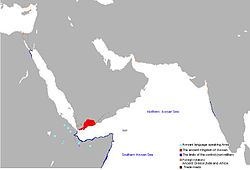|
Awsan
The Kingdom of Awsan, commonly known simply as Awsan (Qatabanian: 𐩱𐩥𐩯𐩬, romanized: ʾwsn; Arabic: أوسان, romanized: ʾAwsān), was a kingdom in Ancient South Arabia, centered around a wadi called the Wadi Markha. The wadi remains archaeologically unexplored.[1] The name of the capital of Awsan is unknown, but it is assumed to be the tell that is today known as Hagar Yahirr (locally named Ḥajar Asfal), the largest settlement in the wadi. Hagar Yahirr was 15 hectares and surrounded by an irrigated area of nearly 7,000 hectares, indicating that it was a formidable power in its time.[2] The main god of Awsan was called Balu (blw).[1] The Kingdom of Awsan experienced two main periods of activity. The first began in the 8th century BC, and in this time, Awsan was militarily allied with the Kingdom of Saba and, together, launched campaigns against common enemies. In the late 7th century BC, this alliance changed into a rivalry and Saba, under Karib'il Watar, obliterated Awsan, then ruled by a king named Murattaʿ. The later kingdom of Awsan experienced a resurgence around or after the 2nd century BC, its independence waning and waxing against Qatabanic control of the area.[3] History8th century BCIn the 8th century BC, Awsan was allied to the Kingdom of Saba. Documents have been found dedicated to the gods and commemorating the brotherhood between the states.[1] Together, Saba and Awsan undertook a successful military ventures against Qataban during the reign of the Sabaean king, Yatha' Amar Watar. The venture was successful, and Saba imposed itself on Qataban as a result.[4] Another continuity between the kingdoms was the use of the title mukarrib to designate their leader, and it is not known which one borrowed it from the other.[5] There is also evidence that Awsan also had contacts with the Jawf valley in the 8th century BC.[6] DestructionIn the late 7th century BC, the alliance with Saba had become a rivalry. During the reign of the Sabaean leader Karib'il Watar, the Kingdom of Awsan was destroyed by Saba and its allies (cities from the Jawf including Nashshan and Haram[7]). Karba'il's victory is recorded in a lengthy inscription known as RES 3945, which records eight campaigns undertaken during his reign, the second of which concerned Awsan. The tribal elite leading Awsan were slaughtered, and the palace of Murattaʿ was destroyed, as well as their temples and inscriptions. The wadi was depopulated, which is reflected in the abandonment of the wadi. Sabaean inscriptions claim that 16,000 were killed and 40,000 prisoners were taken. This may not have been a significant exaggeration, as the Awsan kingdom disappeared as a political entity from the historical record for five or six centuries.[8] The summary of the second campaign in the inscription reads:[9]
There is also evidence that Saba, after defeating Awsan, divided the territory between two of its other allies at the time: Qataban and Hadhramaut.[10] There is evidence that Awsan retained its individuality in these later centuries, at least in the area under Qatabanian control.[11] Brief resurgenceWhen the ability of Qataban to project control over the Wadi Markha declined, the Kingdom of Awsan experienced a resurgence and regained its autonomy for at least a few decades. The timing of this event is unclear. Christian J. Robin proposes a timing in the 2nd century BC, with Jeremie Schiettecatte putting it in the 1st century BC. An extension of this phase into the first centuries AD cannot be ruled out: a 2nd century AD inscription from Saba mentions a war declared against Awsan, but not all are convinced that this data requires the existence of an Awsanite kingdom at the time. This is also the only place and time in the history of ancient South Arabian culture where the king was deified: the only known South Arabian king deified after their death was the Awsanite king Yaṣdaqʾil Farʿam Šarḥiʿat. Some kings from this era are known. Their statues show an iconographic evolution. The earliest kings are shown wearing typical South Arabian clothing, but the last one known is depicted as a Roman citizen, with curly hair and wearing a toga.[12][13] Capital
Hagar Yahirr was the center of an exceptionally large city for South Arabia, influenced by Hellenistic culture, with temples and a palace structure surrounded by mudbrick dwellings, with a probable site for a souq or market and a caravanserai serving camel caravans. One of its kings at this period was the only Yemeni ruler to be accorded divine honours; his surviving portrait statuette is dressed in Greek fashion, contrasting with those of his predecessors who are dressed in Arabian style, with kilt and shawl. There are Awsān inscriptions, in the Qatabānian language. The siting of Ḥajar Yaḥirr is consistent with other capitals of petty kingdoms, at the mouths of large wādīs: Ma`īn in the Wādī al-Jawf, Ma'rib in Wādī Dana, Timna in Wādī Bayhān, and Shabwah in Wādī 'Irmah. ReligionThe main god of Awsan was called Balu (blw).[1] One oracular temple called Nuʿmān is known from Awsan. It was in operation in the 1st century AD, with the oracular god being Wadd.[14] References
Sources
Further reading
External linksWikimedia Commons has media related to Awsan.
|
||||||||||||||||||||||||||||||||||||||||||
Portal di Ensiklopedia Dunia




